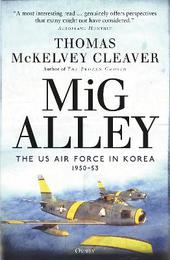
|
MiG Alley: The US Air Force in Korea, 1950-53
Paperback / softback
Main Details
| Title |
MiG Alley: The US Air Force in Korea, 1950-53
|
| Authors and Contributors |
By (author) Thomas McKelvey Cleaver
|
|
Foreword by Col (Ret.) Walter J. Boyne
|
| Physical Properties |
| Format:Paperback / softback | | Pages:336 | | Dimensions(mm): Height 234,Width 153 |
|
| Category/Genre | Military history
Korean war |
|---|
| ISBN/Barcode |
9781472836090
|
| Classifications | Dewey:951.904248 |
|---|
| Audience | |
|---|
| Illustrations |
32pp plate section in b&w
|
|
Publishing Details |
| Publisher |
Bloomsbury Publishing PLC
|
| Imprint |
Osprey Publishing
|
| NZ Release Date |
4 May 2021 |
| Publication Country |
United Kingdom
|
Description
The outbreak of war in Korea caught the United States Air Force in a state of unpreparedness nearly that of Pearl Harbor. The next three years of combat would severely test the service's concept of air power as the lessons of World War II were largely misapplied to the conditions of limited war against a technologically-underdeveloped opponent. Many myths would emerge from the war, the primary one being the absolute supremacy of Air Force pilots and Air Force aircraft over their Soviet-supplied opponents, most particularly that Air Force fighter pilots flying the North American F-86 Sabre had achieved a 10:1 victory-loss ratio over their communist opponents. These myths would go unchallenged until the end of the Cold War when Soviet records were opened and Soviet veterans were interviewed. The Soviet records confirmed that Soviet pilots had fought in the Korean War in organized units and during 1951 had fought their American opponents to a draw, with an approximate 1:1 victory-loss ratio, with Soviet veterans of the Great Patriotic War bringing their combat experience to the battle. No wonder that among the Americans doing the fighting over the Yalu, 1951 was known as "The Year of the Honcho." The Americans were able to improve their record during 1952, when the experienced Soviet units were replaced by less-experienced Soviet units and largely inexperienced Chinese and North Korean units. By 1953, when experienced Soviet pilots returned to combat in Korea, the prospect of an end to the war symbolized by the death of Josef Stalin in March 1953 meant that the newly returned veterans did not fight with the elan and vigor of two years before. During the war, the Air Force system of battlefield air support was demonstrated to be inferior to the close air support of UN ground forces provided by the US Marine Corps and US Navy. Strategic bombing was largely useless due to a lack of strategic targets, the loss of which would drive the enemy to end the war as the Douhet Doctrine on which the Air Force was founded claimed would occur. "MIG Alley" will provide the in-depth analysis of the Air Force War in Korea, packed with interesting and exciting personal stories based on first-person testimony from both American and Soviet sources.
Author Biography
Thomas McKelvey Cleaver has been a published writer for the past 40 years. He is a regular contributor to Flight Journal magazine. He has had a lifelong interest in the Korean War and this work is the product of 25 years of research. He is the author of Aces of the 78th Fighter Group and F4F and F6F Aces of VF-2, as well as Fabled Fifteen: The Pacific War Saga of Carrier Air Group 15 and The Bridgebusters: The True Story of the Catch-22 Bomb Group. During his 30 years as a screenwriter in Hollywood, he wrote the cult classic The Terror Within and worked as a supervising producer on a number of TV and cable series. He served in the US Navy in Vietnam and currently lives in Encino, California.
ReviewsMore than sixty-five years after the Korean War, Tom Cleaver provides an objective assessment of the classic jet clashes along the Yalu River. For decades both the U.S. Air Force F-86s and the Communist MiG-15s claimed a 10-1 victory-loss ratio, an impossibility well known to aviation historians. But with rare resources, MiG Alley demonstrates that the Sabres and MiGs were much closer to parity than previously recognized, while paying tribute to the often outnumbered U.S. pilots who kept enemy airpower off the backs of allied ground forces in the south. * Barrett Tillman, author of 'On Wave and Wing' * Seen as a whole, MiG Alley is a most interesting read, complementing well the author's history of the US Navy's role in Korea, and genuinely offers perspectives that many might not have considered. * Aeroplane Monthly *
|